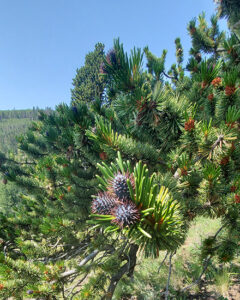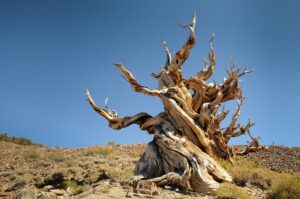
It’s not often a specific tree makes it into a governor’s speech. So, we’ll go out on a limb and say what happened last week at the capitol was an honor 2,500 years in the making.
Colorado Gov. Jared Polis is known for delivering state addresses laced with trivia and pop culture references and, during his fifth State of the State address, he made a shout out to the oldest member of one of Colorado’s more unique tree species — the gnarly bristlecone pine:
I want our state, and our nation, to be a beacon of hope and freedom for all … If we can do that, we will have successfully secured our future for the next 150 years and be an example for the rest of the country to follow at 250. To put things in perspective, that’s barely a quarter of Methuselah’s life on Earth of 969 years, and less than one-tenth the lifetime of Colorado’s oldest 2,510-year-old bristlecone pine.
Gov. Jared Polis
It’s true, 150 years is a drop in the bucket for the state’s oldest bristlecone, which resides on an undisclosed mountainside in South Park — its location kept secret to protect it from vandals. From its vantage point, this bristlecone has recorded eons of climate shifts in its rings. It has been around since the start of Europe’s Dark Ages to the discovery of electricity, from the rise of human hunter-gatherers to waves of tourists snapping up Cartman T-shirts at gas stations in the valley below.
This titan is over 2,500 years old and is one of about 14 living Rocky Mountain bristlecone pines (Pinus aristata) in Colorado confirmed to be more than 1,600 years old. And it’s one of only four known to be over 2,100 years old. These oldest specimens grow in national forests near South Park and along the southern Front Range.
How does a tree survive that long?
Bristlecones are masters at adaptation. They’re most at home in the unhospitable arid, rocky slopes at altitudes up to 11,700 feet, where short summers and challenging weather give them their signature stunted and twisted look. Living in these subalpine areas with sparse vegetation also helps protect them from intense wildfires.
Bristlecones have another unique survival strategy. If a tree is damaged by fire or lightning, part of the xylem tissue, which conducts water under the surface bark, also dies away. In essence, the tree blocks its damaged parts so the surviving branches get a larger supply of nutrients.
Record books of the past
On a sunny June day last year, two foresters from the Colorado State Forest Service and a U.S. Forest Service partner were gathering data in the South Park area as part of the USFS Forest Inventory and Analysis program. As they climbed over 10,000 feet in elevation, they encountered a grizzled bristlecone in their survey area.

“When you look at them, you’re like, ‘Whoa, that’s an old tree that’s just taken a beating,’ ” said CSFS Forester John Barkowski, one of the foresters gathering data. They knew they’d stumbled across an old sentinel like a needle in a haystack.
The FIA program collects and analyzes information on the status, trends and condition of forests across the U.S. To do this, the USFS randomly generates one field sample site for every 6,000 acres of land. These sample plots have a 120-foot radius. Each plot is divided into four subplots for data gathering. The old bristlecone was within one of those subplot sections the foresters were assigned to survey.
“We were just on a plot and found that gnarly tree, just randomly,” Barkowski said. “It was pretty amazing to look at that tree and wonder for a few minutes.”
They used an increment borer to take a small core sample of the tree’s rings, which tells how old the tree is without harming it. Each ring tells the story of a year in the tree’s life.

“The increment borer allows us to look at the age of the tree, but then also looks at how the tree is growing,” Barkowski said. “You can actually see if they’ve been suppressed, if there’s been evidence of drought, fire, that sort of thing. And that gives us a better indication of how the tree is doing. By using the increment borer we’re able to then inform objectives and goals and better understand the condition of the stand.”
It took a while to count the rings, but they came up with about 450 — an old tree by most standards, but still just a baby of the bristlecone world.
New threats to survival
That oldest bristlecone can tell us about how it survived the onslaught of weather and wildfire over the centuries. But what about the road ahead?
A study recently published in the Forestry Ecology and Management journal shows these trees are being threatened by white pine blister rust and mountain pine beetle invasions. And they’re not alone. Dubbed the “high five” by scientists, there are six five-needle pine species found in high elevations across the West gaining attention. Traditionally thought of as subalpine stands with little value for use, these pines include the whitebark, limber, southwestern white, foxtail, Rocky Mountain bristlecone and Great Basin bristlecone. A renewed focus is being put on the benefits the “high five” provide, such as a food source of seeds for birds and wildlife, their capacity to store carbon, and their ability to filter water through their roots.
After counting the rings in the field, the FIA team sent the core sample of the bristlecone they found to the USFS lab in Ogden, Utah, for an official count under a microscope. Climate records for the western United States go back less than 150 years, so forestry scientists take special interest in tree-ring records of ancient bristlecone pines. It’s through their rings they illuminate the history of their surroundings that can’t be found in any book, telling us about wildfires and cold snaps and climate shifts. These are the stories they keep collecting.
“Temperatures have increased over a 30-year period throughout the southern Rocky Mountain Range. These changes would most likely affect trees at higher elevations,” Barkowski said. “There’s evidence that bristlecone pine, however, have survived previous warmer spells so, who knows how they’ll do in the future? They’ve sure withstood all the changes across the landscape before.”

Aged bristlecones can hide in plain sight. At their most majestic, the largest only grow as tall as a two-story house. And that growth happens almost imperceptibly — a U.S. Forest Service study found they only add 1 to 1.5 inches of girth every 100 years.
The telltale sign of an old bristlecone is a sizeable reddish-brown trunk with weathered bark and intricate textures in the wood that have been sculpted by wind, snow and sand. They’re just scraggly, like they’ve been beaten up by weather,” said CSFS Forester John Barkowski.
The bristlecone name comes from the dark purple cones with curved prickles that the tree produces before it matures. The dark color helps the cones absorb the heat they need to reproduce. After the tree matures, the cones turn brown.
The U.S. Forest Service guards the exact location of Colorado’s oldest bristlecone, to protect it from vandals. But bristlecone pines can be found sporadically across the south-central part of the state, usually east of the Continental Divide and as far north as areas near Rocky Mountain National Park.
Places to explore ancient bristlecone forests with many trees over 500 years old include:
- Mount Goliath Research Natural Area – on the Mount Evans Road, near Evergreen. This natural area includes a quarter-mile loop trail to see 700- to 1,600-year-old trees. It was established specifically to preserve and study bristlecones. (Closed in winter.)
- Windy Ridge Bristlecone Pine Scenic Area – northwest of Alma. This scenic area in the Pike National Forest was established in 1964. The Forest Service road to the site requires a high-clearance vehicle or a hike on foot (usually inaccessible in winter).

When Gov. Polis mentioned Methuselah in his State of the State address, he was referring to the biblical figure said to have lived to the age of 969. Incidentally, the oldest known bristlecone pine also is named Methuselah, in homage.
At more than 4,800 years old, this Great Basin bristlecone (Pinus longaeva) has long been thought to be the oldest living nonclonal tree on earth, meaning a tree that doesn’t share a root system. It grows in an ancient bristlecone forest called Schulman Grove, in California’s Inyo National Forest.
But a Patagonian Cypress tree in Chile named Gran Abuelo (Great Grandfather) is challenging Methuselah’s record. If initial age estimates can be confirmed, Gran Abuelo may be over 5,400 years old. The scientist leading the research hopes to publish findings this year.

